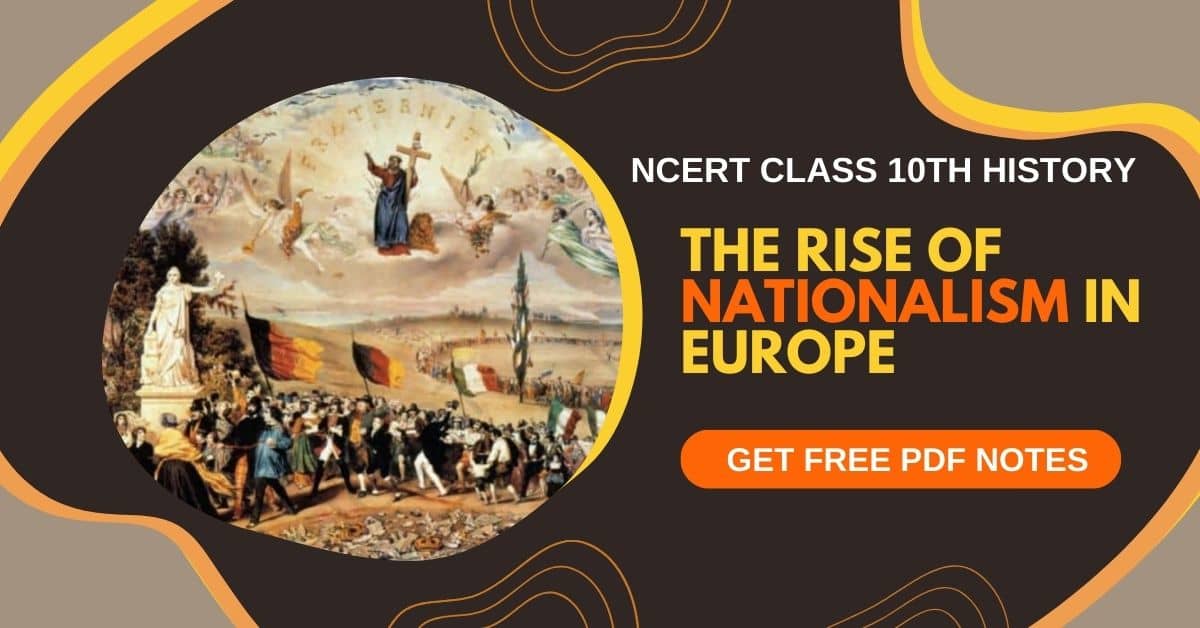Introduction to The Rise of Nationalism in Europe – Concept & Notes PDF
Topic covered: Introduction to The Rise of Nationalism in Europe: The Rise of Nationalism in Europe (All single details that are exam-oriented)
Exam-Oriented Notes on 1st Chapter of NCERT Social Science for Class 10th: The Rise of Nationalism in Europe and the Emergence of Nation-States in Nineteenth-Century Europe.
Download the PDF of NCERT for Class 10th Social Science History Notes Chapter 1 – The Rise of Nationalism in Europe
We have attached the class 10 history chapter 1 notes pdf “the rise of nationalism in Europe notes pdf” in this blog you can download it from our website for quick revision for your examination.
The Rise of Nationalism in Europe
1. Frédéric Sorrieu’s Artistic Vision (1848):
- A French artist.
- Series of four prints envisioning ‘democratic and social Republics.’
- The first print depicts people of Europe and America offering homage to the Statue of Liberty.

2. Symbolism in Sorrieu’s Vision:
- Liberty is personified as a female figure.
- Torch of Enlightenment and Charter of Rights of Man as symbols.
- Shattered remains of absolutist symbols on the earth.
3. Utopian Representation:
- Peoples of the world are grouped as distinct nations.
- Identified through flags and national costumes.
- Leading the procession: United States and Switzerland, established nation-states by 1848.
4. German Unification Symbolism:
- German people with the black, red, and gold flag.
- Representation of liberal hopes in 1848 to unify German-speaking principalities.
5. Sequence of Nations in Sorrieu’s Vision:
- France was identifiable by the revolutionary tricolour.
- Sequence: Germany, Austria, Kingdom of the Two Sicilies, Lombardy, Poland, England, Ireland, Hungary, and Russia.
6. Heavenly Symbolism:
- Christ, saints, and angels symbolize fraternity among nations.
- It was used by Sorrieu to convey a sense of unity in the world.
Chapter Focus: Changes in Nineteenth-Century Europe:
7. Emergence of Nationalism:
- The nineteenth century was marked by the rise of nationalism.
- Significant impact on the political and mental landscape of Europe.
8. Shift from Dynastic Empires to Nation-States:
- Result: Emergence of the nation-state.
- Replacing multi-national dynastic empires.
- Centralized power exercising sovereign control over defined territories.
9. Development of Modern State Concepts:
- Evolution of modern state concepts over time in Europe.
- Centralized power and sovereign control over a defined territory.
10. Nation-State Defined:
- The majority of citizens, not just rulers, share a common identity.
- Shared history or descent developed through struggles and actions of leaders and common people.
11. Forging Commonness:
- Common identity is not inherent but forged through struggles.
- The actions of leaders and common people contribute to the development of shared history.
12. Diverse Processes of Nation-States and Nationalism:
- The chapter explores various processes leading to the emergence of nation-states.
- Examines the role of leaders and common people in shaping national identities.
- Focus on the dynamic and evolving nature of nationalism in nineteenth-century Europe.
Key Takeaways for Exam Preparation on “The Rise of Nationalism in Europe“
- Understand Sorrieu’s artistic vision and symbolism.
- Recognize the sequence of nations in Sorrieu’s utopian representation.
- Grasp the impact of nationalism on the political and mental world of Europe.
- Analyze the transition from dynastic empires to nation-states.
- Comprehend the development of modern state concepts and the forging of common identity.

